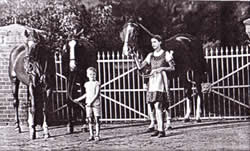
PALACE - history
Zalesie belonged to Szubin landed estate that formerly had belonged to the Paluks. The oldest notes about Sedziwoj Paluk, who ruled there, come from 1365. Sedziwoj was one of the governors of Kingdom of Poland after Ludwik Wegierski’s death. He was the one who brought Queen Jadwiga to Poland.
The Czarnowski who belonged to the noble clan of Nalecz were the next owners of Szubin landed estate. Adam Sedziwoj Czarnowski was one of the most respected senators among the gentry and aristocracy. After his death, his wife sold the large part of the estate to her son-in-law Krzysztof Opalinski arms-bearing Lodz. Earlier Opalinski had inherited two towns and approximately 50 villages. He was one of the main senators and for a period of time he served as a voivode of Poznan province.
The estate was divided and Zalesie was given to one of the three Kiehn’s sons - Carl Goetlib Kiehn. In 1869 he was the one who built the present palace, distillery, and farm buildings. After his death Georg Kiehn, his son, inherited the estate. He was said to be a great manager and he developed the palace, he built a ball room and an additional wing. His daughter Frieda Leokadia, who inherited Zalesie, married Otto von Rost - cavalry captain. In the 30s the estate became famous for hunts, balls and horse races. Ellen Streeten (von Rost) remembered that Otto von Rost always hold birthday parties for all his friends and neighbours. The von Rost family owned the palace till the Second World War.
In August 1946 Zalesie was taken over by State Treasury. After 1946 the palace hosted: School of Agriculture, Inspectorate office of PGR (state-owned farm), Headquarters of PGR, Welfare Services Company ‘Zalesie”, guest rooms, a conference room and employees’ flats on the first floor.
In 1950 the palace was electrified. From 1973 to 1982 the building was undergoing constant redecorations. As a result openwork heater covers from an interwar period were gone. Apart from that a kitchen lift was removed and ceiling stucco was partly taken off.
Since 1993 the palace belongs to the Oczkowski family. They do their best to bring the building to its former glory.
PALACE - architecture
Before we reach the main entrance we need to pass a terrace supported by four pillars and Ionic columns. The observation deck above the portico is surrounded by an openwork balustrade with balusters. It is decorated with stone flower pots and sandstone poles and from the below it is ornamented with acanthus leaves.
The palace walls are decorated with acroterions, and above the entrance there is a relief of a lion mounted at the apex of the pediment. The lion probably refers to the von Rosts’ family crest. You should see outstanding ornaments on eastern walls – a capital that resembles Corinthian column with acanthus leaves.
From the north we can see a glass and metal porch with historical flooring - Villeroy & Boch tiles ornamented with plant motifs on borders. Similar flooring you can find by the main entrance and in all basements..
The ground floor consists of two-way space with corridors, halls and a fine ball room which is very bright thanks to large windows. Almost all wooden doors (often double) in the palace come from the period before the Second World War. The missing wood work is consistently being restored by present owners. As a result all palace doors and windows look alike. For ages the windows have been protected by Neo-Baroque bars. The ground and first floor is connected by two staircases. Both stairs are built from massive granite blocks. One of the stairs is unique even in Europe since its steps are built with the use of the law of gravity. The balustrade is made of metal with plant ornaments. Apart from historical decorations, the palace still has some original equipment. For instance you can see a tiled corner stove with a crown of dark green tiles that was built at the time the palace was erected, it is in a neo-classical style.In front of the entrance, there is a circular drive, lawn with a stone basin of a fountain. In the middle of the lawn there is a huge maple tree - a natural feature of historic importance. The park is located in the north part of the estate and it was probably founded in an Italian style by Stanislaw Mycielewski in 18th century. It is quite probably it had avenues of trees, garden houses, pavilions, beauty spots and a pond. You can encounter a lot of these elements. As far as the park is concerned, it is important to mention a yew tree that is 500 hundred years old. Moreover you can find a 300-year-old cypress and lots of other unique old trees. At present the park has been cleaned, self-sown plants have been removed, and the owner started to work to bring back the historical layout of alleys and garden architecture.
In Zalesie you can also see a distillery built in 1869, old warehouse with a characteristic superstructure with merlons, and a charming coach house. What’s more there is also a former wheelwright’s and blacksmith’s shop and a watchtower where there used to be a clock. Hopefully the owner will be able to restore the clock in the nearest future.
There are legends that say the palace basements lead to the cemetery and blacksmith’s shop, so there are still things to be discovered...











